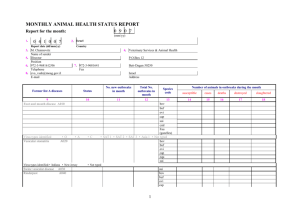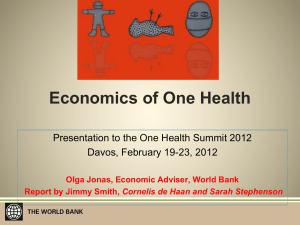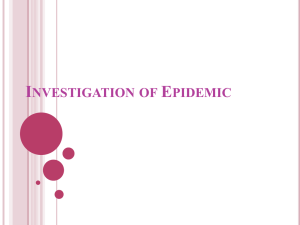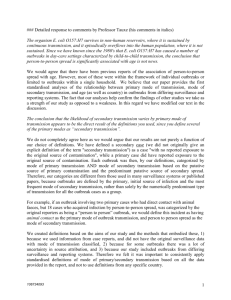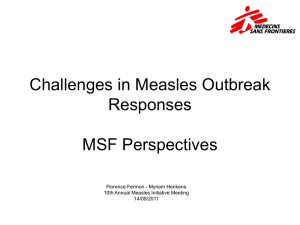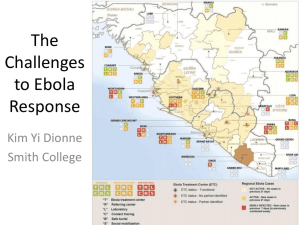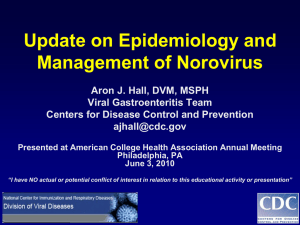Outbreaks
advertisement
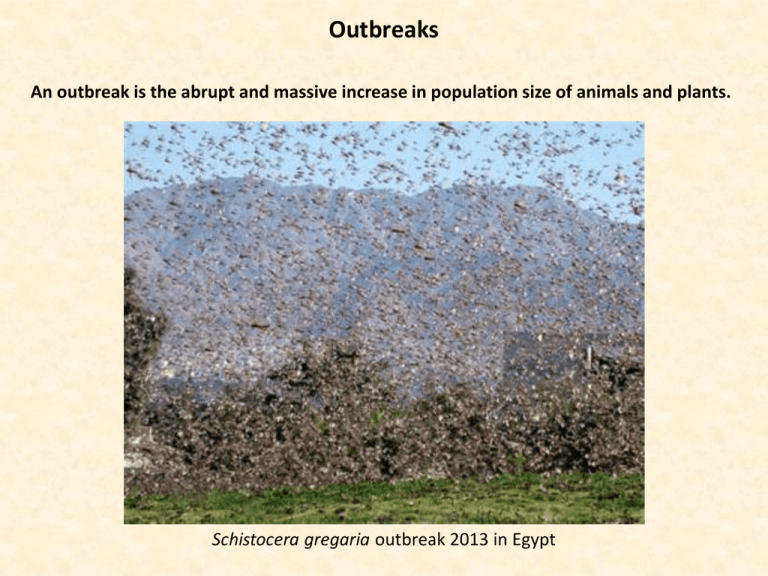
Outbreaks An outbreak is the abrupt and massive increase in population size of animals and plants. Schistocera gregaria outbreak 2013 in Egypt Barbosa et al. 2012 Coccinella septempunctata outbreak 2011 in Northern Germany Lemmus lemmus Lemming outbreaks are triggered by winter breeds and by changes in survival that cause additional breeds Ims et al. (2011) Proc Natl Acad Sci USA. 108: 1970– 1974. Korpimaeki et al. 2004, Bioscience 54: 1071-1079. Spruce budworm Choristoneura fumiferana Cameraria ohridella Jellyfish blooms in Eastern Asian seas Nemopilema nomurai Causes for Nemopilema blooms are increased water temperatues, over fishing, polluted waters, and saltier waters, dead zones, and redirected ocean currents. Blooms are made by anthropogenic factors The Rocky Mountain locust (Melanoplus spretus) ranged through the western half of the USA and part of Canada until the end of the 19th century. It was a typical prairy species. The last living species was seen in 1902. During the last half of the Nineteens century it had several mass outbreaks and constant high population sizes. Probably the species died out by prairy irrigation of settlers. Extinction was human caused. Mast years in plants as a special form of gradation Many trees have more or less regulalry mast years (Oak, Beech, castan, but also fruit trees. Mast years occur in cycles of five to ten years. 2013 was in Poland a mast year for apples. A chronogram of oak masts in the Southern Apalachian (Speer 2001, http://web.utk.edu/~grissino/downloads/James%20Speer%20dissertation.pdf) Common ecological characteristics (life history trades) of outbreak species • Phytophages (rarely paraisoids or predators) • r strategists Number of species Monophagous Polyphagous Coniferous host Deciduous host Body size 34 13 19 26 6 Nonoutbreak species 176 79 92 115 56 1.0-1.95 2.0-2.95 > 3.0 mm Facultative multivoltine Strictly multivoltine 1 6 24 8 8 58 56 45 16 7 Outbreak species • High reproductive output • Short reproduction times • Multiple annual breeds • High dispersal rates • Regulated by predators • Polyphages These are not sufficient conditions for an outbreak species! P(c2) 0.56 0.11 <0.0001 0.22 Data from Koricheva et al. 2012, Insect Outbreaks Revisited Causes for defoliation by herbivore insect outbreaks (Mattson et al. 1991) • Defoliation severity increases directly with homogeneity of the forest composition. • Defoliation severity increases with the average amount of exposure of the individual tree crowns. • Defoliation severity increases, though not necessarily linearly, with tree age. • Defoliation severity increases with warm, dry weather during the growing season. • Defoliation severity increases with the folivore's predilection for polyphagy. • The effects of defoliation on tree vigor are cumulative and not linear. Classification of outbreak species Stable erruptions Unstable high equilibrium Pulse erruptions Permanent erruptions Cyclic erruptions Stable high equilibrium Stable low equilibrium Population Unstable low equilibrium Average outbreaks of herbivores last 2 to 4 years, outbreak duration rarely exceeds 10 years. Sustained eruptions Cyclic eruptions Bark beetles (Scolytidae) Larch Tortrix (Zeiraphera griseana) Pulse eruptions Gypsy moth Lymantria dispar The gypsy moth develops on over 300 differed tree species including gymnosperms and angiosperms Population size Temporal pattern of outbreaks Population size Time Upper population limit Predators control populations Habitat conditions amplify population growth Starvation and disease reduce populations Outbreak level Time Mechanisms of outbreaks Environmental factors • Favourable weather conditions • New resources • Threshold effects Intensive modelling showed that the direct impact of environmental conditions is generally much too small to explain the magnitude of outbreaks. Outbreaks are caused by ecolgical factors that amplify reproduction rates. 𝑁𝑡 = 𝑁𝑡 + 𝑟𝑁𝑡−1 𝐾 − 𝑁𝑡−1 𝐾 Thed discrete Pearl - Verhulst model of population growth A high increase is population size is linked to a high reproductive output. Any factor combination that increases r might be an amplifier for outbreaks. Rain might serve as an amplifier Abundance Schistocera gregaria Swarming Larger gregarious form Smaller stationary form Drought Rain Drought Swarming Smaller stationary form Larger gregarious form Rain Drought Time Consumption rate Important amplifiers are: Escape from enemies Relative mortality caused by generalist predators of type II or type III functional response decreases with increasing prey density. The greater is the population density, the faster it grows. Type III US state Maine population outbreak 1924 Prey density Type II Prey density N Reproductive output Type I 1996 Gypsy moth Lymantria dispar Data from Williams and Liebhold (1995) Lymantria dispar Random regional weather conditions Time Physiological oak mast cycles Time Mast failures Time Small mammal population cycles Time Mast failures cause breakdown of small mammal population during winter Low spring predation of small mammals after mast failures cause outbreaks of the gypsy moth winter Time Important amplifiers are: Threshold effects Some bark beetles (Scolytidae) might succeed in attacking a healthy tree only when the number of beetles is large. When the density of adults is high, then they cause considerable damage and the tree looses its resistance to developing larvae. Beetle abundance After reaching a certain threshold density population increase becomes positively density dependent and results in an outbreak. Threshold Tree damage Important amplifiers are: Habitat effects Population of spider mites grow very fast at high temperature. They live on plant leaves where local temperature is lower than the ambient temperature. T. urticae is extremely polyphagous 16 90 12 70 8 50 15 20 25 30 Temperature Number of eggs Tetranychus urticae Developmental time During the draught, plant transpiration is reduced, and thus, the temperature of leaves increases causing rapid reproduction of spider mites. Citation 35 Higher temperature increases fecundity and decreases developmental times leading to accelerated pupolation growth Drought Increased temperature Decreased humidity Plants Increased Temperature Stress metabolites Osmolytes Sugars Secondary compounds Decreased Growth Resistance Water content Natural enemies Increased Decreased Abundance Phytophagous insect Increased Decreased Resources Adult survival Plant utilisation Larval survival Enemy escape Growth of symbionts Rate of reproduction Outbreak Important amplifiers are: Habitat effects Pine sawflies, Diprion pini, have >50% of their population in a prolonged diapause lasting from one to five years. Drought may cause reactivation of a large proportion of diapausing sawflies. Diaprion outbreak in Germany was finished by the outbreak of the red backed vole Abundance Diprion pini Clethrionomys glareolus 1964 1965 Time 1966 Turced 1966, Waldhygiene 6: 181-182 Outbreaks collapse usually due to one of the following mechanisms: •Destruction of resources •Natural enemies •Unfavorable weather The Clark and Holling (1979) model of insect outbreaks a is related to the strength of biotic interaction C. S. Holling 1930r is the intrinsic growth rate 𝛼𝑁𝑡−1 2 𝐾 − 𝑁𝑡−1 𝑁𝑡 = 𝑁𝑡−1 + 𝑟𝑁𝑡−1 − 𝐾 1 + 𝛽𝑁𝑡−1 2 Logistic growth Interaction b is related to the effects behaviour of the species How to derive the model? 𝑇𝑆 = 𝑇 − 𝑇𝐻 𝑃 𝑃 = 𝑠𝑇𝑆 𝑁 Predation P is proportional do prey density N and to effective search time TS. Effective search time TS is the difference between total search time T and handling time TH. 𝑃 𝛼𝑇 = 𝑁 1 + 𝛼𝑇𝐻 𝑁 Predator efficacy or pedator rate Consumer abundance The model describes Holling’s type II functional response. Resource abundance 𝑃 = 𝑠 𝑇 − 𝑇𝐻 𝑃 𝑁 𝑠𝑁𝑇 𝑃= 1 + 𝑠𝑇𝐻 𝑁 Holling’s disc equation 𝐾 − 𝑁𝑡−1 𝑁𝑡 = 𝑟𝑁𝑡−1 −𝑃 𝐾 𝑇 = 𝑞𝑁 Searching time is 𝑇𝐻 = 𝑜𝑁 proportional to prey density 𝛼𝑁𝑡−1 2 𝐾 − 𝑁𝑡−1 𝑁𝑡 = 𝑁𝑡−1 + 𝑟𝑁𝑡−1 − 𝐾 1 + 𝛽𝑁𝑡−1 2 Monocultures Do monocultures increase the probability of outbreaks? Monocultures are often devoid of natural enemies. Outbreak species asre of opf higher density. Monocultures provide high resource densities ? Outbreak species are often polyphagous. Tropical forests often face severe insect outbreaks. The proportion of potential outbreak species is higher in tropical forests. Do outbreaks harm ecological systems? ? In terms of economy: yes. In terms of ecosystem functiong: probably no Outbreaks lead to higher resource turnover. Post-outbreak systems increase in species richness. Outbreak might lead to evolutionay innovations. Leptinotarsa decemlineata


